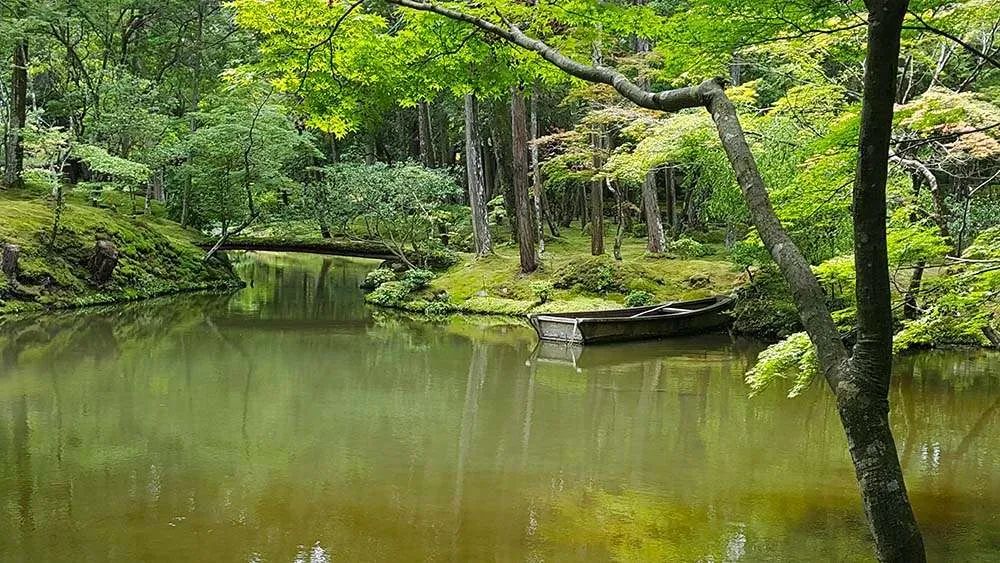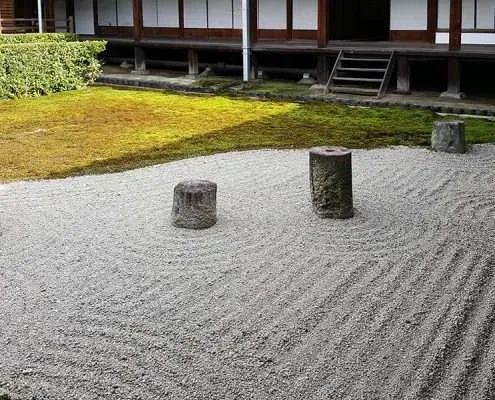
![]()
文 | 阿甘兄
【原文地址】:https://www.interactiongreen.com/jobs-zen
"Simplicity is the ultimate sophistication." - Steve Jobs
“简单是复杂的最高境界” - 史蒂夫·乔布斯
It is well known that Steve Jobs practiced Zen. It influenced his design philosophy and is reflected in Apple’s minimalist, no-frills-allowed style.
众所周知,史蒂夫·乔布斯修行禅宗。这种修行影响了他的设计哲学,并体现在苹果公司简约至上、不允许有任何多余装饰的风格中。
“I have always found Buddhism—Japanese Zen Buddhism in particular—to be aesthetically sublime […] The most sublime thing I’ve ever seen are the gardens around Kyoto.” (Walter Isaacson, How Steve Jobs’ Love of Simplicity Fueled A Design Revolution)
“我一直都认为佛教—特别是日本的禅宗—在美学上是极为崇高的 […] 我所见过的最崇高的事物就是京都周围的那些花园。”(沃尔特·艾萨克森,《史蒂夫·乔布斯对简约之爱的驱动下的设计革命》)

Jobs practiced the Soto school of Japanese Zen, working with Kobun Otogawa as his long-time mentor. The Soto school is one of the major Japanese Zen schools known for its strict focus on Zazen (sitting meditation), called “Shikantaza,” which means “do nothing but meditation.”
乔布斯修行的是日本禅宗的曹洞宗,他与小川小孃(Kobun Otogawa)长期保持师徒关系。曹洞宗是日本禅宗的主要宗派之一,以其对坐禅(静坐冥想)的严格专注而闻名,这种坐禅被称为“只管打坐”,意为“除了冥想什么都不做”。
This “nothing but” is tricky because you are not even permitted to have a purpose in meditating. Instead of trying to become mindful or feel peaceful, you must vacate your body and mind of any thoughts, feelings, desires or expectations. By focusing on meditation itself – nothing else – you become an empty vessel. That’s how Buddha achieved Nirvana. The Soto school attempts to follow Buddha’s path to find eternal truth through meditation.
这种“什么都不做”实际上颇具挑战性,因为你甚至不被允许在冥想中有目的性。你不是试图变得专注或感到平和,而是必须清空你的身体和头脑中的任何思想、感情、欲望或期望。通过专注于冥想本身—除此之外别无他物—你变成了一个空的容器。这就是佛陀实现涅槃的方式。曹洞宗试图通过冥想来追随佛陀的道路,寻找永恒真理。
Through his pursuit to vacate his body and mind to reach truth, Jobs seems to have found ultimate beauty. It’s probably not a coincidence that art is an integral part of Zen, and the design aesthetic of Jobs’ creative spirit resonated with Zen.
通过追求清空身体和心灵以达到真理,乔布斯似乎发现了终极之美。禅宗中艺术的不可或缺,以及乔布斯创造性精神的设计美学与禅宗的共鸣,可能并非巧合。
ZEN IS THE ART OF SUBTRACTION
禅宗是减法的艺术

Zen strongly believes in that our body and brain can achieve more when finally released from greed, by persevering arduous training. Zen also believes that the process cannot be cut short by studying texts. In order to fully understand something, you need to comprehend it physically. So Zen denies the text.
禅宗坚信,当我们的身体和大脑最终从贪婪中解脱出来,并通过艰苦的训练,我们能够获得更多的成就。禅宗还相信,这个过程不能通过学习文本而被缩短。为了完全理解某些事物,你需要身体上的理解。因此,禅宗否定了文本的重要性。
This is the reason why prominent Zen monks in the Middle Ages used various forms of art, such as the Zen garden, calligraphy or flower arrangement to crystallize what they saw and felt during their journey for eternal truth. And it was this very restriction – no text allowed – that resulted in the “aesthetic sublime” of Zen arts, as described by Jobs.
这正是为什么中世纪的杰出禅宗僧侣使用各种形式的艺术,如禅宗花园、书法或花道来凝聚他们在追求永恒真理的旅途中的所见所感。正是这种限制—不允许使用文本—导致了禅宗艺术的“美学崇高”,正如乔布斯所描述的那样。
Zen art is a creative process of subtraction. In the same way as they moderated their desires and feelings through meditation, Zen priests (inseparable from artists) examined each and every element in art to decide if it was really necessary. They patiently continued the questioning process until ultimate essentials finally emerged. This is very much like how Steve Jobs, a trailblazer and perfectionist, pursued an aesthetic philosophy that would eventually define Apple’s minimalist, simple and yet playful brand identity.
禅宗艺术是一个减法的创造过程。就像他们通过冥想来调节自己的欲望和情感一样,禅宗僧侣(与艺术家不可分割)审视艺术中的每一个元素,以决定它是否真的必要。他们耐心地继续提问的过程,直到最终的基本要素浮现出来。这与史蒂夫·乔布斯非常相似,他是一位开拓者和完美主义者,追求一种美学哲学,最终定义了苹果公司的极简主义、简单而又有趣的品牌形象。
Jobs’ belief in the power of simplicity as a design precept reached its pinnacle…the iPod, iPhone and iPad…His main demand was “Simplify!”…If he wanted a song or a function, he should be able to get there in three clicks…If he couldn’t figure out how to navigate to something, or if it took more than three clicks, he would be brutal. “There would be times when we’d wrack our brains on a user interface problem, and think we’d considered every option, and he would go, ‘Did you think of this?’” said Tony Fadell, the team leader. “He’d redefine the problem or approach, and our little problem would go away.” (Walter Isaacson, How Steve Jobs’ Love of Simplicity Fueled A Design Revolution)
史蒂夫·乔布斯对简约作为一种设计原则的力量的信仰达到了顶峰……iPod、iPhone 和 iPad……他的主要要求是“简化!”如果他想要一首歌或一个功能,他应该能够在三次点击之内获得……如果他无法弄清楚如何导航到某个地方,或者如果需要超过三次点击,他就会非常严厉。“有时候我们会绞尽脑汁思考一个用户界面问题,认为我们已经考虑了所有选项,然后他会问,‘你们考虑过这个吗?’”托尼·法德尔(Tony Fadell),团队负责人说。“他会重新定义问题或方法,我们的小问题就会消失。”(沃尔特·艾萨克森,《史蒂夫·乔布斯对简约之爱的驱动下的设计革命》)
It is a daunting task to persevere in the process of subtraction until essential elements are revealed. We are too familiar with addition, and we often assume that more added things mean added value. But Zen priests and Jobs knew that this was not necessarily the case. Many details only serve to dilute and distract the essence by adding superfluous values.
坚持减法过程直到揭示出基本要素是一项艰巨的任务。我们对加法太过熟悉,我们常常假设增加的东西意味着增加的价值。但是,禅宗僧侣和乔布斯知道情况并非必然如此。许多细节只会通过增加多余的价值来稀释和分散本质。
Take the example of the Zen garden, which Jobs found “aesthetic sublime…” to see how the art of subtraction works. Jobs especially liked Saiho-ji, also known as koke-dera, in Kyoto.
以乔布斯发现的“美学崇高”的禅宗花园为例,来看看减法艺术是如何运作的。乔布斯特别喜欢京都的西芳寺,也称为苔寺(Koke-dera)。
STEVE JOBS LOVED SAIHOJI (KOKEDERA), PRESTIGIOUS KYOTO ZEN TEMPLE WITH BEAUTIFUL ZEN GARDEN
史蒂夫·乔布斯热爱西芳寺(苔寺),这是一座享有盛誉的京都禅宗寺庙,拥有美丽的禅宗花园。
|
|
|
|
The Saiho-ji garden, Kyoto, designed by Muso Soseki in the 14th century. Top: The ground level that employs chisen kaiyu-shiki design. Bottom: The upper level that employs kare-sansui design.
京都的西芳寺花园,由14世纪的梦窗疎石设计。上图:采用地泉回游式设计的底层。下图:采用枯山水设计的上层。
It is intriguing that Jobs loved the Saiho-ji, which has two distinct faces. Saiho-ji garden was designed by Muso Soseki, a prominent Zen priest in the 14th century who founded the fundamentals of the Zen garden and kare-sansui design.
有趣的是,乔布斯热爱的西芳寺拥有两种截然不同的面貌。西芳寺的花园是由14世纪著名的禅宗僧侣梦窗疎石设计的,他奠定了禅宗花园和枯山水设计的基础。
The ground level (top image) employs a technique called chisen kaiyu-shiki. It has a pond at the center, and lanes, gazebos and vista points quietly surround it. The Chisen kaiyu-shiki garden is visually abundant because at its core is a body of water, the substance which provides life for all living things on Earth. At Saiho-ji, the abundant water nourishes the abundant flora. Hundreds of years after Muso Soseki, today there are about 120 different moss species that display their quiet vigor. That’s why it’s also called koke-dera (the moss temple).
地面层(上图)采用了一种名为地泉回游式的技术。花园中心设有一个池塘,周围静谧地环绕着小径、亭子和观景点。地泉回游式花园在视觉上非常丰富,因为它的核心是水体,水是地球上所有生物生命的源泉。在西芳寺,丰富的水资源滋养着丰富的植物群落。数百年后的今天,约有120种不同的苔藓品种在这里展示着它们的静谧活力。这也是它被称为苔寺(moss temple)的原因。
The upper level (bottom image) is totally different. Abundant vegetation suddenly disappears and the world of kare-sansui emerges. Developed by Muso Soseki, kare-sansui means “expressing greens and water using no life.” It primarily employs rocks, pebbles and mossy mounds to describe the boundless beauty of nature. The ponds, which play a central role in chisen kaiyu-shiki gardens, are absent in kare-sansui. The most prominent kare-sansui at Saiho-ji is situated on the slope to a hill, beside a small religious building. Surrounded by crude nature sit several forceful, but succinct rocks. The rocks are arranged to represent carp climbing up a waterfall to become dragons – a transformation based on an old Chinese myth. This is where Muso Soseki actually performed his meditation.
上层(下图)则完全不同。茂密的植被突然消失,枯山水的世界显现出来。枯山水是由梦窗疎石发展起来的,意为“使用无生命之物来表达绿色和水”。它主要使用石头、卵石和苔藓覆盖的小丘来描绘自然的无限美丽。在地泉回游式花园中起核心作用的池塘,在枯山水中是不存在的。西芳寺最突出的枯山水位于一座小山坡上,旁边是一座小型宗教建筑。在原始自然的包围中,坐落着几块有力而简洁的岩石。这些岩石被排列成代表鲤鱼跃过瀑布化身为龙的形象—这种转变基于一个古老的中国神话。这就是梦窗疎石实际进行冥想的地方。

On the ground level, you are submerged in a mesmerizing and sensual abundance of green. You are literally filled with silent power of green. It is euphoric.
在地面层,你会沉浸在令人着迷且感官丰富的绿色之中。你几乎被静谧的绿色力量所充满。这是一种令人欣喜的感觉。
But climbing up higher, the scene changes drastically. The effect caused by the absence of abundant water is evident. Suddenly you are thrown into the arms of untamed nature.
但是当你向上攀登,景象发生了剧烈的变化。缺少丰富水源的影响变得显而易见。突然间,你仿佛被投入到了未被驯服的大自然的怀抱中。

This is an aggressive subtraction process. In order to appreciate what’s going on here, it is necessary to learn a little bit more about kare-sansui.
这是一个激进的减法过程。为了理解这里所发生的事情,有必要进一步了解枯山水。
更多查看原文,这里不再继续往下写......








 本文探讨了史蒂夫·乔布斯如何深受禅宗影响,将简约原则融入设计,通过冥想和减法艺术,如禅宗花园,追求极致的美感。乔布斯的创新理念体现在苹果产品的设计中,强调直观易用和去除冗余,体现了禅宗的哲学和美学。
本文探讨了史蒂夫·乔布斯如何深受禅宗影响,将简约原则融入设计,通过冥想和减法艺术,如禅宗花园,追求极致的美感。乔布斯的创新理念体现在苹果产品的设计中,强调直观易用和去除冗余,体现了禅宗的哲学和美学。


















 被折叠的 条评论
为什么被折叠?
被折叠的 条评论
为什么被折叠?








